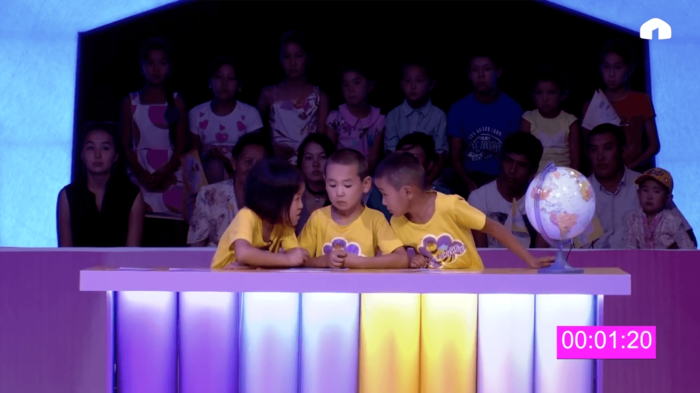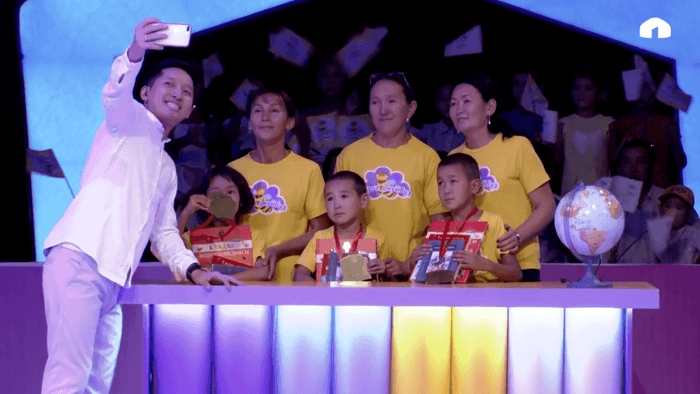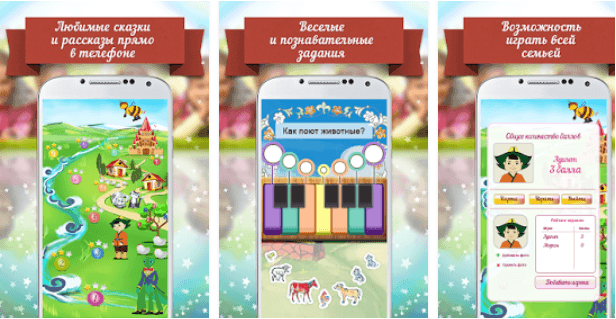Can television get people to engage with books? TV often lures people – especially young people – away from reading. But one educator in Central Asia imagined a way to use the excitement of television and competition to make books exciting for young readers.
The TV series that Burulai Aitikulova pioneered in the Kyrgyz Republic has shown over a million viewers how to read and enjoy books together. Aitikulova, Senior Education Advisor with the Aga Khan Foundation, already had an impressive streak of innovation with Reading for Children, an initiative that fosters a love of reading with picture books and stories that families can read and discuss together. That program has spread to 10 countries in Asia and Africa.
Now she and Aga Khan Foundation, with support from donors and a Kyrgyz national broadcasting corporation, took that innovation two steps further, with a television program that engages families across the country and beyond, and a mobile app that extends the reach of books to anyone with a phone in remote and under-served communities.
Reading Together TV
This year the program, “Reading Together,” broadcasts its fourth season, 26 episodes each year, on national television. A review of TV ratings in 2015 found that Reading Together ranked #6 in the channel’s Top 10 Programs, reaching 1.1 million viewers.
The program format marks an innovative way to use the nationwide reach of television to engage communities that are often marginalized – and get more families to read. Studies show that a child who reads with her family does better in school and gains important life skills. “Reading Together” makes that fun.
Every Episode a New Contest
Each episode in the series features three books with a shared theme, such as environmental protection or building relationships. In the latter example, “What Makes Me Smile” gets paired with two other books with similar messages. Together the books allow viewers to explore an issue from several perspectives.
There are six contestants; children aged 7 to 12 years old, each with a parent or another adult – grandparent, aunt or sister. Each episode has contestants at three reading levels: beginner, medium, and advanced. The show selects participants based on their responses to SMS announcements for upcoming episodes. The contestants come from all over the country, with their travel expenses covered by the program.


One family comes to the capital from Naryn to the south, another comes from Talas in the north, etc. “They get to know each other through the show,” explains Burulai. They meet on the program’s set and after dividing into teams, they compete two at a time. For each question, they have 30 seconds to discuss their answer among themselves. Then they receive scores for their answers.
The show also involves role play as they perform a scene from the book. For those scenes, they invite their parents to participate. “Dad is a bear, Mom is a fox, etc.” Another segment asks parents, “How well do you know your child?” The emcee asks each parent about their child’s favorite food, book, etc. independent from the child’s answers, and then viewers see both sets of answers. This spurs conversations between parents and children in the audience. The show also demonstrates how to read passages from books together as celebrities read passages from the books.
At the end of the show, the emcee announces the winning team and they receive medals. Each participating team is awarded a package of children’s books (stories, encyclopedias) that families can rarely afford.
Reaching Distant Audiences
Besides watching the show broadcasts, viewers can also watch the show online where it gets between 700-1,000 views per episode. The online access is a boon to Kyrgyz families abroad, including many living in Russia for work. “Being in Russia,” said Burulai, “they don’t have access to Kyrgyz TV programs. So we can say with confidence that we reach the children of work migrants.”
Burulai says early reading content, in addition to reaching rural and out-of-country audiences, also gets broadcast on another channel called “World of Children” (“Balastan”), which airs AKF-produced video spots about Early Child Development, funded by Johnson & Johnson.
Influencing Classroom Practice
One unexpected result of the TV programming for reading is that teachers have adapted the show’s format in the classroom, as a way to engage students with new topics. Kyrgyz schools present classes as “Let’s Read Chemistry” or “Let’s Read Geography.” Teachers find that the format improves relationships between teachers and parents.
An Innovation that Crosses Borders
Beyond Kyrgyzstan, the producers have received requests to broadcast the show in other countries. Half of the first season of Reading Together was in Russian, so a Russian-language TV channel in St. Petersburg asked permission to broadcast those episodes there.
Agencies of the Aga Khan Development Network in other countries have also shown interest at education conferences. “I never thought when I started the Reading for Children program back in 2006 that it would go to another stage, and then another stage,” said Burulai.
“At the end of each show, parents come up and express their thanks. They say, ‘Now I’ll read with my child at home. Now I know how to read,’” she added.
For Burulai, hearing the parents reach that point of engagement is very satisfying.
Taking Reading Further with Mobile Apps
With the show’s success nationwide, the producers also pioneered a mobile app, with technical partner Avisa. The goal of the app is to give children in remote communities access to Kyrgyz books on their phones in places where physical books are scarce. Users can find all the titles published by Reading for Children on the Reading Through Playing app. The app is available on the Google Play Store in three languages: Kyrgyz, Russian, and English.

The U.S. Agency for International Development provided support for developing a second app, Fun Kitep 2 (Reading is Fun). That app has already been downloaded 5,000 – 50,000 times from the Google Play Store.
Both apps have been receiving rave reviews. One user wrote, “Well done! It is a great program for children!” Other reviewers were just as enthusiastic: “THANKS to the developers!!!! 5 stars.”
The AKF education team has developed a third mobile app on care for child development messages with the support of Johnson & Johnson. The application, called BalAppan, is also available in the Google Play Store. It contains messages for parents on how young children develop, videos on child care and development, and examples of toys parents can make from inexpensive materials, such as puzzles, rattles and colorful objects.
Feeling Validated for Innovation
“When you get to act on your new ideas and get support, it moves you forward,” said Burulai. To be on a national TV channel with millions of viewers, several times a week, and each time it includes the AKF logo that says, ‘This is supported by the Aga Khan Foundation.’” Burulai smiled. “I think that is something huge.”